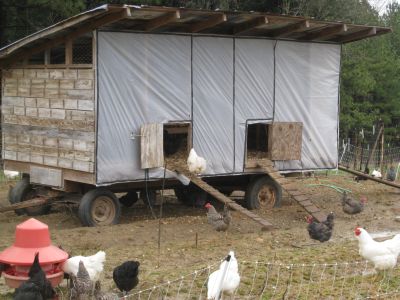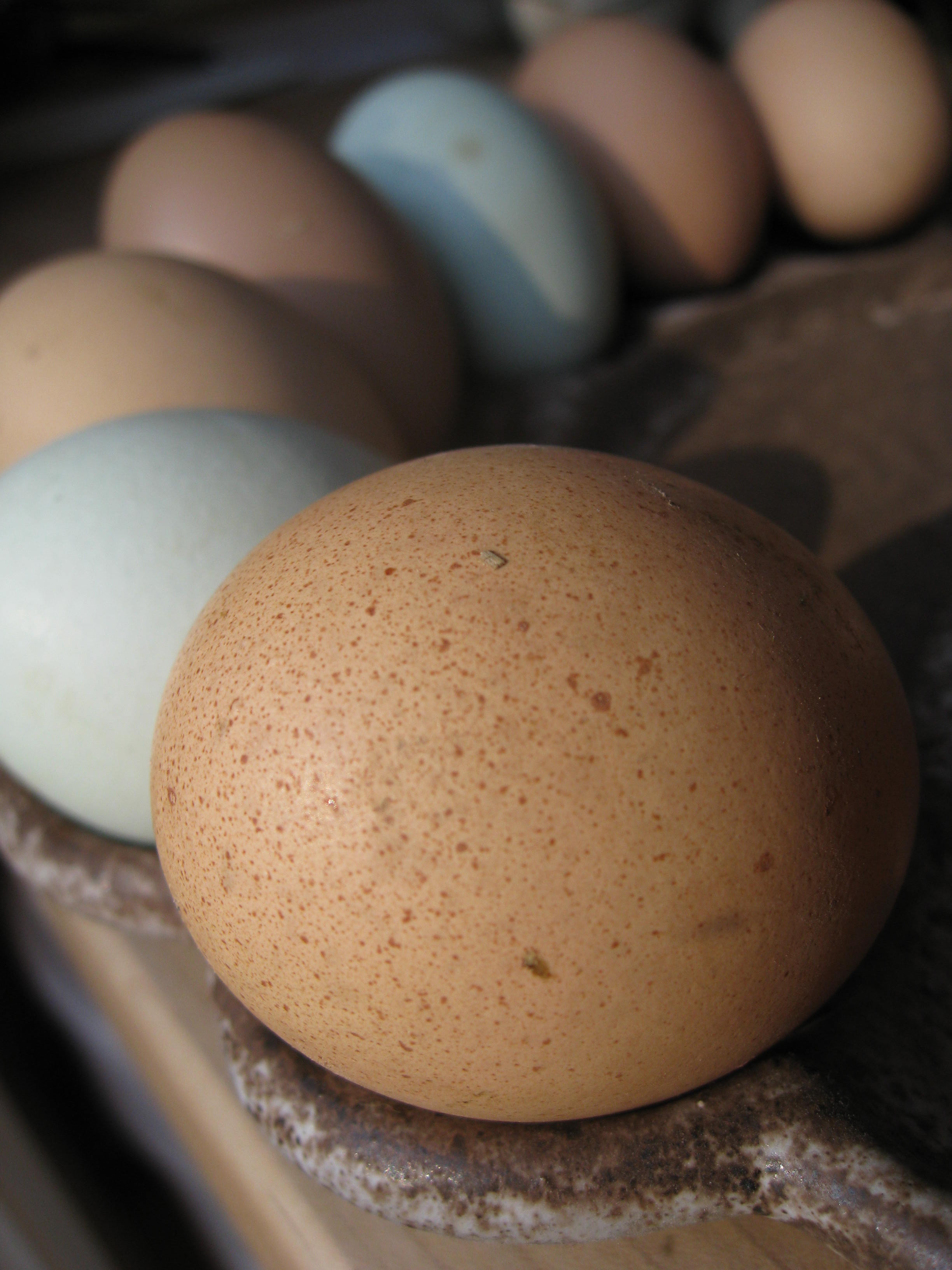
Before moving on to the more glamorous spring harvests of asparagus, sweet peas, and strawberries, let us first praise the pastured farm egg. That’s right: Eggs, too, have a season.
Spring has long represented the beginning of a new cycle, and eggs are the epitome of rebirth. Easter egg huntshave their origins in ancient Pagan spring traditions associated with the Goddess of Fertility.
In natural conditions, hens’ egg production is dependent on hours of daylight. During short winter days, egg production slows down drastically or even stops. Come spring, longer days spur egg production. Plus, increased sunlight means lots of new growth for the hens to graze. Even the organic “free-range” eggs that you can buy in grocery store are fed grains and are rarely, if ever, allowed to peck and forage grass or bugs. Common sense tells us that chickens that eat healthier, more diverse diets produce more nutritious eggs, and recent studies confirm this traditional wisdom
First-time eaters of eggs from pastured chicken immediately recognize how different they are from their caged-hen-produced counterparts. Charming on the outside, they range in color from blue to brown, some with freckles and others with textural bumps. The vivid mango-colored yolks are startling at first, and when you crack them in a pan the yolks stand up high, rounded and firm. Your troubles of breaking the yolk when frying or poaching eggs, or when separating eggs from whites, are virtually over, since farm fresh eggs are stronger, denser, and more intact. Restaurant cooks and pastry chefs love pastured eggs for this reason. And let us not forget their superior taste. The eggs are richer and tastier, reflecting their grassy terroir.
Egg It On
As people increasingly participate in feeding themselves, backyard chickens are becoming more common in cities across the United States. In some cities like my neighboring Durham, North Carolina, citizens have successfully organized to overturn rules forbidding urban hens. The benefits of backyard hens are many, including mosquito and tick control, providing fertilizer for backyard gardens, and increasing household food security.

Much roosting, but no roosters.
Photo: April McGreger
Backyard eggs also stimulate neighborhood-scale barter economies. In my baking-oriented household, eggs are as good as hard currency. Our most recent negotiation involved farm eggs in return for one of my husband’s paintings; and we’ve been known to trade anything from kimchi to cooking lessons to banjos for them. Trade economies foster relationships and strengthen communities.
The internet offers a plethora of information to help you raise your own urban hens with no less trouble than a cat or a dog, but with the added benefit of fresh eggs. But you don’t need to create a “barnyard in your backyard” to enjoy spring eggs. Early-season farmers markets typically offer sufficient eggs to supply even the latest riser; and flock-tending neighbors are likely looking for a good trade.
Once procured, the freshest eggs need little adornment, but a few simple techniques deliver transcendence. Soft scrambled eggs on buttery toast are a revelation to many. Somewhere along the way, I learned to toss a few tiny cubes of very cold butter into my eggs to produce super creamy eggs without ultra-slow cooking. (You still want to use only moderate heat, however.) A perfect 6-minute, soft boiled egg on tender spring lettuces with chewy chunks of bacon and sharp vinaigrette is worthy of stellar glass of wine and a starched white tablecloth — but requires neither. A bowl of buttery, artisanal grits with an over-medium egg and a drizzle of red-eye gravy is perfection. Decidedly restrained devilled eggs made with only a bit of powdered mustard, the finest grated shallot, a dab of homemade mayonnaise, salt, and snipped chives are my go-to spring potluck dish. More elaborate dishes, such as quiches, savory bread puddings, and frittatas, combine fresh spring produce and farmstead cheeses with pastured eggs for elegant casual dinners and lazy brunches.
For home bakers, an abundance of high-quality eggs invites new perspective as well. So often relegated to the supporting role, now is the egg’s turn capture the spotlight. This calls for egg-y custards, buttery curds, and meringue pies. I can think of no better ode to the spring egg than a vibrantly yellow lemon meringue pie. Just add a bouquet of butter-yellow daffodils and the sound of chirping birds for an instant spring garden party.
Spring Onion, Bacon & Herb Bread Pudding

Slice o’ spring
Photo: April McGreger
I first enjoyed a version of this deeply satisfying and beautiful savory bread pudding baked in the bread crust as a staff meal made by my friend Monica Segovia-Welsh when we worked together in the kitchen at Chapel Hill-based Lantern. This recipe is meant to be a guide, as it is endlessly adaptable to whatever moves you at the market. It is delicious made with mushrooms or asparagus or various greens and is equally at home on the brunch or the dinner table. Serve alongside a salad with mustard-laced vinaigrette.
1 loaf of day old country or sourdough bread or 5 cups 1 ½” bread chunks
Filling
5 slices bacon, chopped OR 3 Tbsp olive oil
6 young spring onions, scallions, or small leeks, coarsely chopped
1 clove garlic, chopped
1/2 cup flat-leaf parsley, chopped
1 tbsp fresh thyme, chopped
1 1/2 cups milk
1 1/2 cups heavy cream
5 fresh eggs from pastured hens
3/4 tsp salt
1/2 tsp black pepper
A few gratings of fresh nutmeg
1/2 cup Gruyere, Fontina, or other melting cheese, grated
2 Tbsp Pecorino Romano or Parmigiano-Reggiano, grated
Topping
1/4 cup grated Gruyere or other melting cheese
Preheat oven to 375 degrees F.
Cut a circle out of the top a round loaf of sourdough or country bread. With your hands, hollow out the bread, leaving the sides and bottom of the crust intact. Cut or tear the bread into 1 ½-inch pieces. Measure 5 cups of the bread chunks and set aside. Reserve the leftovers for another purpose. If your bread is fresh, toast it in the oven for a few minutes to dry it out.
Butter the inside of the hollowed out bread bowl or a 2 1/2 quart baking dish.
If using the bacon, sauté it in a large skillet over medium heat until crisp. Remove bacon from skillet with a slotted spoon and place on a paper towel to drain. Saute’ the spring onions in the bacon drippings (or olive oil) for 3-5 minutes, until soft. Add the garlic, parsley, and thyme and cook for 2 minutes more. Remove from heat and set aside.
To make the custard, in a mixing bowl whisk together the eggs, milk, cream, salt, pepper, nutmeg, and cheese. Toss the bread with the custard. Then stir in the spring onion mixture and the reserved bacon. Fill the buttered bread mold with the bread custard filling. Top with the remaining 1/4 cup cheese and place on a baking sheet to catch any overflows. If you have any leftover filling, you can butter a small ramekin and bake it separately.
Bake until the custard is no longer runny, about 45 minutes. If the top starts to get too dark before the custard is fully baked, cover with aluminum foil.
The dish is delicious hot or at room temperature.
Lemon Meringue Pie

Pie oh my
Photo: April McGreger
Come spring, my Southern roots demand all sorts of little celebrations. I want garden parties complete with daffodils and tulips, minted iced tea, chicken salad tea sandwiches, devilled eggs, salads of tender butter lettuce and chive dressing, and most of all I want dramatically swooped & mounded lemon meringue pies. I am partial to the intoxicating fragrance of Meyer lemons but they offer a slightly sub par pucker to the standard lemon.One pre-baked 9-inch pie crust (see the crust recipe from this previous column.)
Lemon Curd
3/4 cup sugar
2 Tbsp grated lemon zest
3/4 cup freshly squeezed lemon juice
3 large eggs
4 egg yolks
Pinch salt
1 stick unsalted butter, cut into ½” pieces
Swiss Meringue
1/2 cup egg whites, (3-4 whites)
3/4 cup plus 2 tbsp sugar
Pinch of salt
Pulp of ½ vanilla bean, split and scraped
To make the curd, bring 2 cups of water to a boil in a medium saucepan. Turn down to a steady simmer. Combine the sugar and the lemon zest in a stainless steel bowl and rub together between your fingers. Whisk in the lemon juice, eggs, yolks, and salt. Place the bowl over the simmering water and cook, stirring constantly with a whisk or rubber spatula until the mixture is very thick, coats the back of a spoon and/or registers 170 degrees F on an instant thermometer.
Set the mixture aside, stirring occasionally until it cools slightly, about 7 minutes. Then whisk in the butter 1 Tablespoon at a time until it is thoroughly melted. I like to use an immersion blender or food processor to do this, especially if I am doing a larger batch.
Fill pie or tart shells immediately or cover tightly and refrigerate for up to one week. The curd is also delicious with toast or scones.
To make the meringue, bring 2 cups of water to a boil in a medium saucepan. Turn down to a steady simmer. Combine the egg whites, sugar, salt, and vanilla bean pulp in a the bowl of a stand mixer or other stainless steel bowl. Rest the bowl securely on the rim of the saucepan of simmering water. The bottom of the bowl should not touch the water. Whisk the egg whites over the water until they are hot to the touch (around 120 degrees F). Remove from heat and beat with a whisk attachment until the mixture is thick and holds stiff, glossy peaks.


